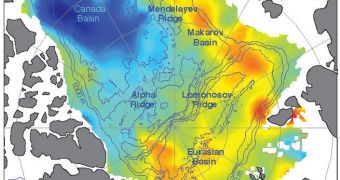A collaboration of researchers from the University of Washington and the American space agency has recently determined that the Eurasian half of the Arctic Ocean has been contributing important amounts of freshwater to the area over the past decade. This could have significant implications on the ocean.
This previously unknown redistribution of freshwater stirs the Arctic Ocean. This happens because the incoming amounts of freshwater are transferred towards the Canadian sector of the Arctic, experts say.
The most startling thing about the new discovery is not that Russian rivers are contributing large amounts of freshwater to the northern ocean, but that this influx is strong enough to affect the ocean conveyor belt, a balance of currents and winds that transfers heat around the world.
This belt is the only reason why Europe is not covered in glaciers all the way to the shores of the Mediterranean Sea. The belt makes a curve in the Northern Atlantic Ocean, where it releases a lot of heat, which is then pushed eastwards by prevailing winds, all over Europe.
UWS Applied Physics Laboratory oceanographer and lead study author Jamie Morison says that he and his colleagues were thus far unable to discover any nominal changes in the conveyor belt, which is good news.
But the addition of freshwater also has some benefits as well, such as the fact that the liquid is more lightly-colored than water produced by the melting of Arctic ice fields. This means that it absorbs less heat, breaking off a vicious circle that leads to the accelerated melting of ice sheets at the North Pole.
“Knowing the pathways of freshwater is important to understanding global climate because freshwater protects sea ice by helping create a strongly stratified cold layer between the ice and warmer, saltier water below that comes into the Arctic from the Atlantic Ocean,” Morison explains.
“The reduction in freshwater entering the Eurasian Basin resulting from the Arctic Oscillation change could contribute to sea ice declines in that part of the Arctic,” the investigator goes on to say.
NASA Jet Propulsion Laboratory (JPL) senior research scientist Ron Kwok says that two satellite missions – Grace and ICESat – allow investigators to keep an eye on several critical aspects related to the Arctic.
“To better understand climate-related changes in sea ice and the Arctic overall, climate models need to more accurately represent the Arctic Oscillation's low pressure and counterclockwise circulation on the Russian side of the Arctic Ocean,” Morison concludes.

 14 DAY TRIAL //
14 DAY TRIAL //